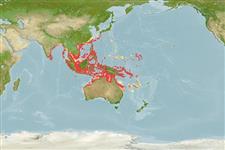分類 / Names
俗名 | 同種異名 | Catalog of Fishes(屬, 種) | ITIS | CoL | WoRMS | Cloffa
Teleostei >
Eupercaria/misc (Various families in series Eupercaria)
鱸形目 (Various families in series Eupercaria) >
Caesionidae (Fusiliers)
烏尾鮗科 (Fusiliers) > Caesioninae
Etymology: Caesio: Latin, caesius, bluish-grey, 1835; it is the same name given to the silvery metal (Cs) (Ref. 45335).
More on author: Bloch.
Environment: milieu / climate zone / depth range / distribution range
生態學
海洋 礁區魚類; 非遷移的; 深度上下限 1 - 60 m (Ref. 86942). 熱帶; 31°N - 28°S, 76°E - 172°E (Ref. 402)
Indo-West Pacific: Sri Lanka to Vanuatu; southern Japan to northern Australia.
印度-西太平洋: 斯里蘭卡到萬那度; 日本南部到澳洲北部。
大小 / 重量 / 年齡
Maturity: Lm ? range ? - ? cm
Max length : 60.0 cm TL 雄魚/尚未辨別雌雄; (Ref. 402)
背棘 (總數) : 10; 背的軟條 (總數) : 14 - 16; 臀棘: 3; 臀鰭軟條: 10 - 12. Deep-bodied (Ref. 48636). Scales center lighter than margins; lower 1/3 white, sometimes suffused by pink; prominent black markings on caudal fin absent. 4-5 scales on cheek; predorsal scales 20-26; scaled dorsal and anal fins. Upper peduncular scale rows 9-11; lower peduncular scale rows usually 12-14. Distinguished from C. teres in having a continuous supra-temporal band of scales across the dorsal midline. Basioccipital process for attachment of Baudelot's ligament absent. Post maxillary process single; posterior end of maxilla blunt. Color: Upper body if not yellow, grayish blue; lower sides and belly white or pinkish. Pectoral, pelvic and anal fins white to pink. Large yellow tail. Dorsal fin yellow posteriorly and grayish blue anteriorly. Length usually at 35 cm (Ref. 48636). Head length 2.8-3.6 in SL; body depth 3.0-4.2 in SL (Ref. 90102).
身體縱深.(參考文獻 48636) 鱗片中心顏色淡的超過邊緣; 低的 1/3 白色,有時充滿了粉紅色; 在尾鰭上的突出的黑色斑紋不存在。 在頰上的 4-5 鱗片; 前背的鱗片 20-26; 覆有鱗片的背鰭與臀鰭。 上柄的鱗片列 9-11; 下柄的鱗片列通常 12-14. 在上方在有一個方面與 C. teres 區分了連續-橫過背部中線的鱗片的當時條紋。 對於 Baudelot 的結帶的附著的基枕骨突起不存在。 後顎的突起單個; 顎骨的後端鈍的。 顏色: 身體上半部如果不是黃色, 灰藍色; 下側與腹部白色或略帶桃色的。 胸鰭,腹鰭與臀鰭白色到粉紅色。 大的黃色尾部。 背鰭黃色在後部地與灰藍色前面地。 長度通常在 35 公分.(參考文獻 48636)
Often in silty areas with low visibility at 1-30 m depth (Ref. 90102). Inhabits coastal areas, usually over rocky and coral reefs. Forms schools in midwater and feeds on zooplankton. Oviparous, with numerous, small pelagic eggs (Ref. 402). Taken primarily by handline in Sri Lanka; caught mostly by fish traps in western Thailand and Malaysia; caught in trawls in the Gulf of Thailand; caught by a variety of methods including drive-in nets, fish traps and gill nets in Indonesia, the Philippines and Papua New Guinea. The most ancestral living caesionid species.
棲息於沿岸區域, 通常在岩石與珊瑚礁上面。 在中層水域中形成魚群並且吃浮游動物。 卵生的, 有很多的, 小型大洋性魚類卵.(參考文獻 402) 在斯里蘭卡主要以手執的釣絲捕獲了; 在泰國西部與馬來西亞大部份被魚籠捕捉; 在泰國灣在拖網捕獲了; 被在印尼,菲律賓與巴布亞新幾內亞包括圍網,魚籠與刺網的多種方法捕獲了。 最原始的活 caesionid 種。
Life cycle and mating behavior
成熟度 | 繁殖 | 產卵場 | 卵 | 孕卵數 | 仔魚
印度-西太平洋: 斯里蘭卡到萬那度; 日本南部到澳洲北部。
Carpenter, K.E., 1987. Revision of the Indo-Pacific fish family Caesionidae (Lutjanoidea), with descriptions of five new species. Indo-Pac. Fish. (15):56 p. (Ref. 1723)
IUCN 瀕危狀態 (Ref. 130435: Version 2024-1)
無危 (LC) ; Date assessed: 06 March 2015
人類使用
漁業: 商業性
工具
特別的報告
下載 XML
網路資源
Estimates based on models
Preferred temperature (Ref.
123201): 26.1 - 29.1, mean 28.3 °C (based on 1120 cells).
Phylogenetic diversity index (Ref.
82804): PD
50 = 0.5020 [Uniqueness, from 0.5 = low to 2.0 = high].
Bayesian length-weight: a=0.01622 (0.00944 - 0.02787), b=3.07 (2.92 - 3.22), in cm total length, based on LWR estimates for this species & (Sub)family-body (Ref.
93245).
營養階層 (Ref.
69278): 3.4 ±0.45 se; based on food items.
回復力 (Ref.
120179): 中等的, 族群倍增時間最少 1.4 - 4.4年 (Preliminary K or Fecundity.).
Fishing Vulnerability (Ref.
59153): Moderate vulnerability (44 of 100).
Nutrients (Ref.
124155): Calcium = 40 [26, 56] mg/100g; Iron = 0.627 [0.417, 0.912] mg/100g; Protein = 19.1 [18.1, 20.0] %; Omega3 = 0.13 [0.09, 0.18] g/100g; Selenium = 37 [24, 62] μg/100g; VitaminA = 85.9 [35.4, 208.2] μg/100g; Zinc = 0.991 [0.741, 1.300] mg/100g (wet weight);
